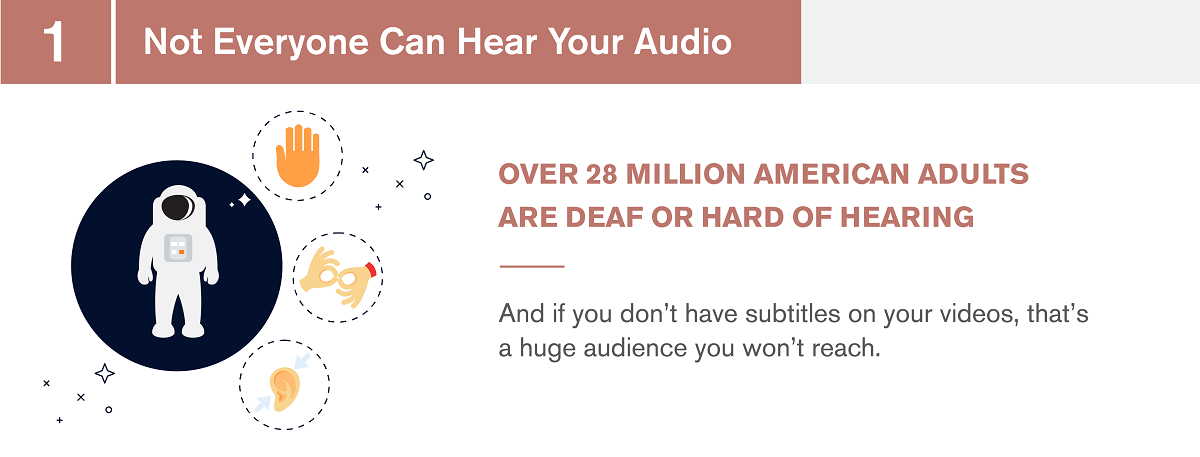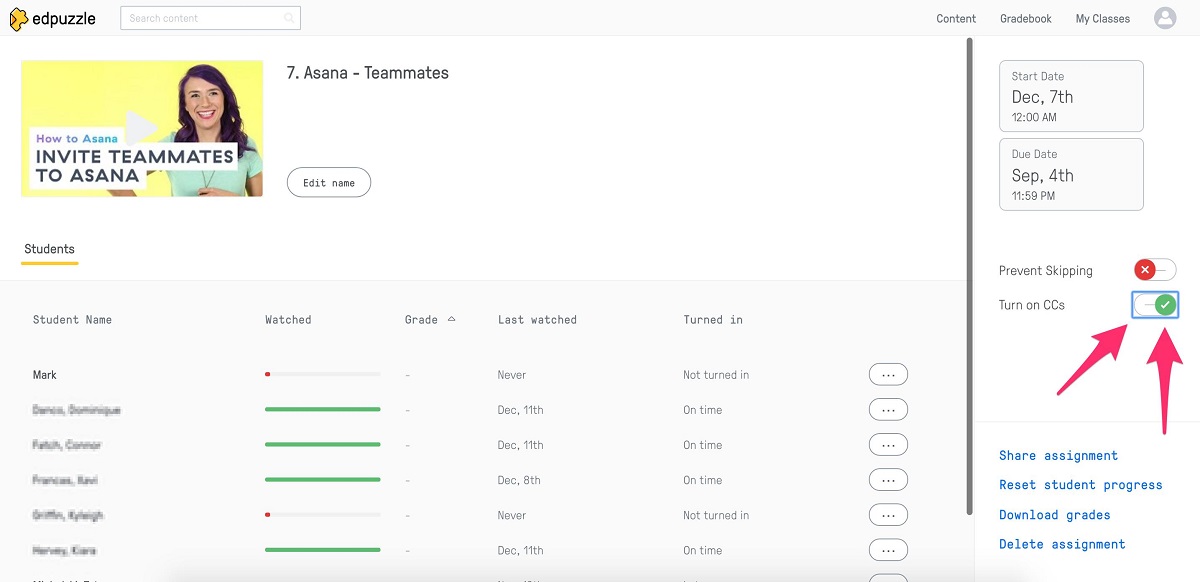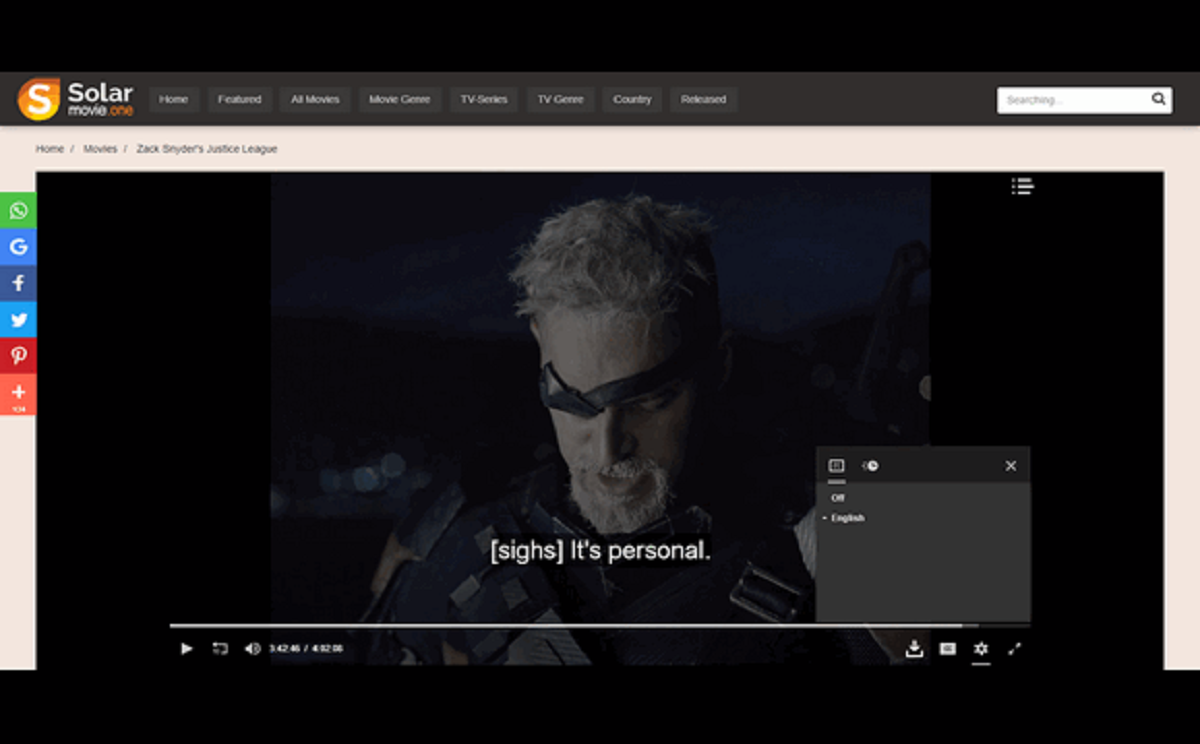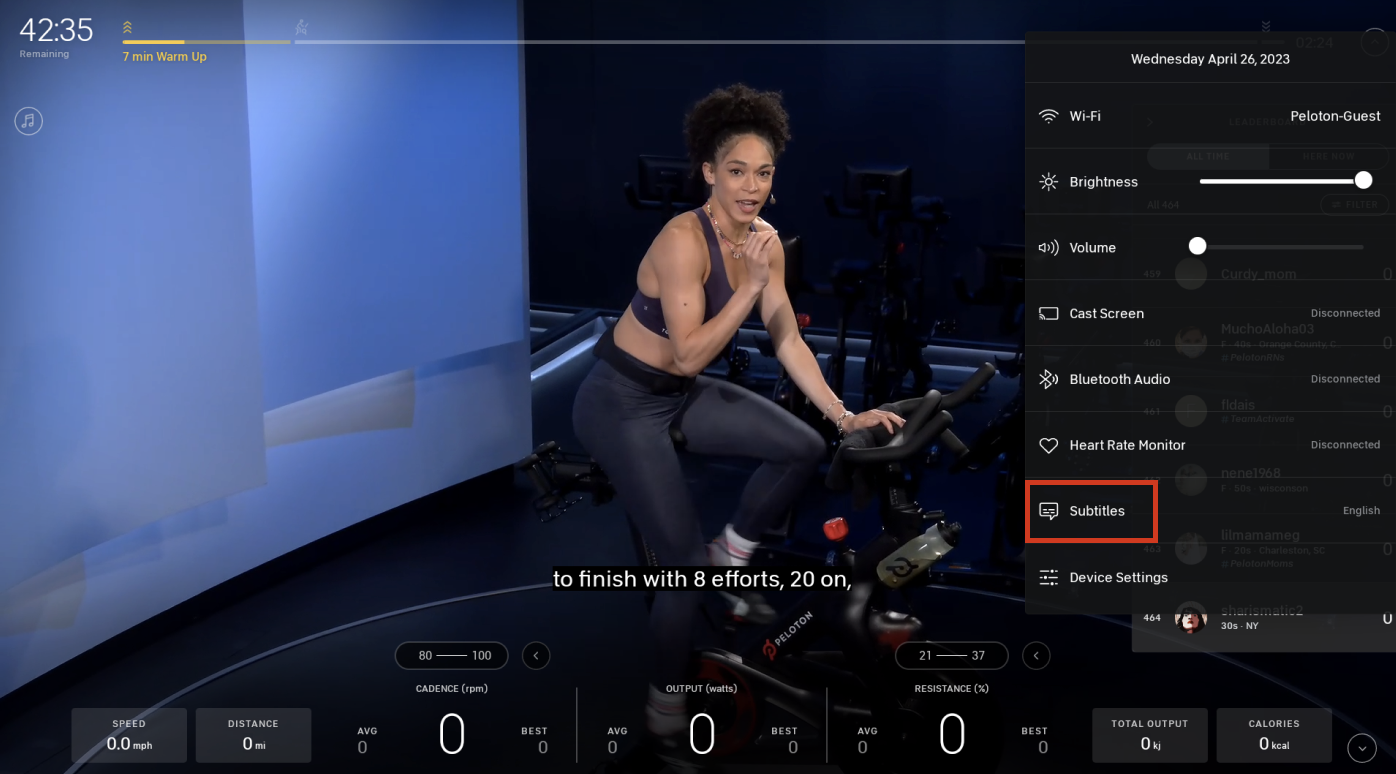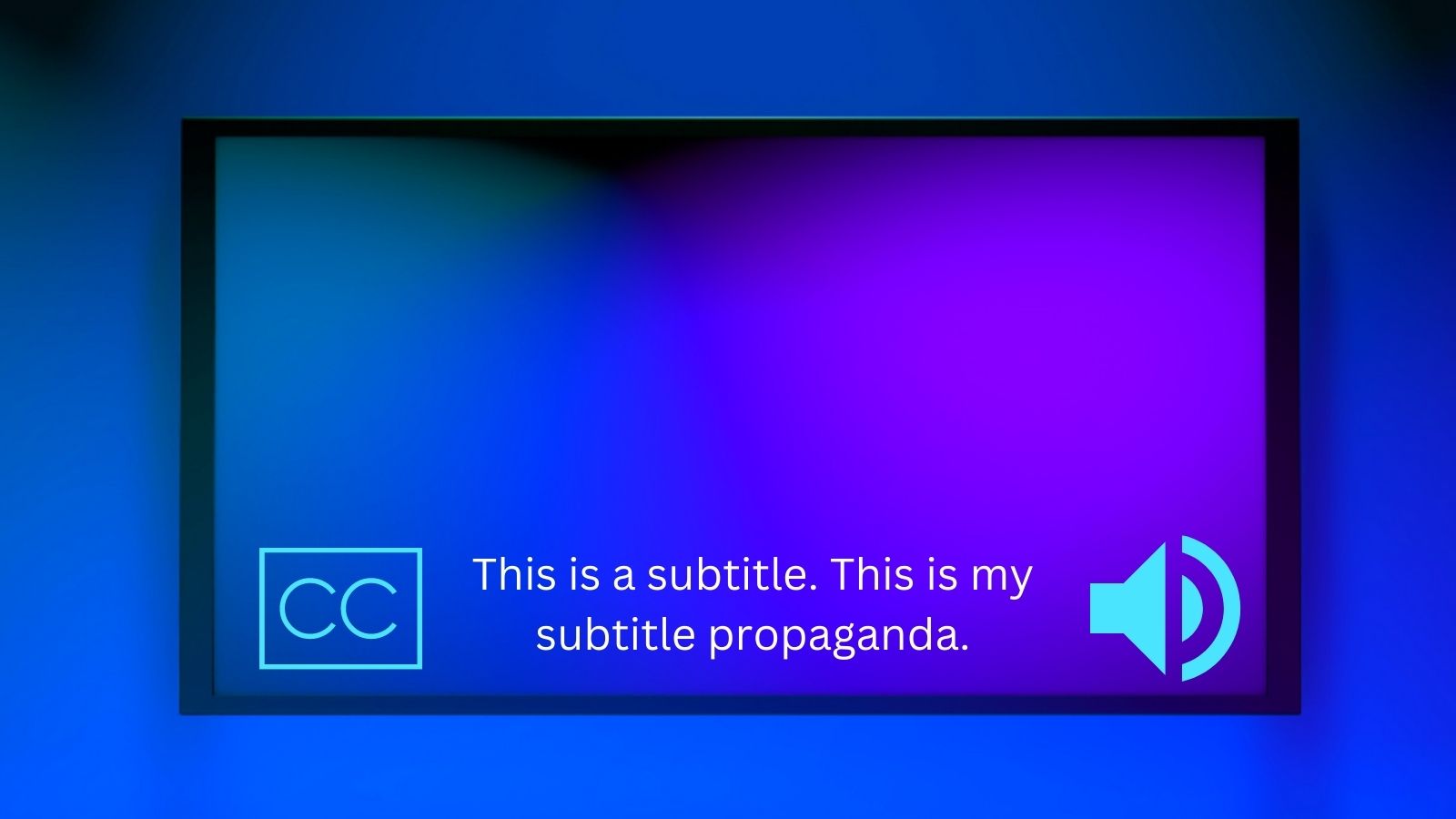Introduction
Have you ever found yourself struggling to focus on a movie, TV show, or video lecture? Do you often catch your mind wandering and missing important details? If so, subtitles may be the answer to your focus-related woes.
Subtitles, also known as closed captions, are textual representations of the audio content in a video or audio file. They are typically displayed at the bottom of the screen, synchronized with the dialogue or narration, providing a written transcript of what is being said.
While subtitles were originally designed to assist individuals with hearing impairments, they have become increasingly popular even among those with normal hearing. Whether you struggle with distractions or simply want to enhance your viewing experience, subtitles can be a game-changer.
In this article, we will delve into the benefits of using subtitles and how they can improve your focus and comprehension. We will also explore how subtitles can serve as a learning tool and make content accessible to the hearing-impaired. So, let’s dive right in and discover why subtitles are more than just words on the screen.
What are subtitles?
Subtitles are textual representations of the spoken dialogue or narration in a video or audio file. They are typically displayed at the bottom of the screen and provide viewers with a written transcript of what is being said. Subtitles can be in the same language as the audio or translated into a different language.
Subtitles serve several purposes, making content more accessible and engaging for a wide range of viewers. They are commonly used in movies, TV shows, documentaries, online videos, and educational materials.
There are two types of subtitles: open captions and closed captions. Open captions are burned into the video and cannot be turned off, whereas closed captions can be toggled on or off by the viewer. Closed captions allow individuals to choose whether or not they want to see the subtitles, providing flexibility depending on their preferences or requirements.
Subtitles are not only beneficial for individuals with hearing impairments. They can also enhance the viewing experience for anyone, regardless of their hearing ability. By providing a visual representation of the audio, subtitles help viewers to better understand and follow along with the dialogue or narration.
Furthermore, subtitles can be used to translate content into different languages, making it accessible to a global audience. This is particularly useful for foreign films or videos, enabling viewers who may not be proficient in the original language to still enjoy and comprehend the content.
With the increasing popularity of online streaming platforms and video-sharing websites, subtitles have become more widespread. Many platforms now offer automatic captions generated by speech recognition software. While these automatic captions may not always be 100% accurate, they still provide a helpful starting point for viewers.
In the next section, we will explore the benefits of using subtitles, including how they can improve focus and concentration while watching videos or listening to audio content.
The Benefits of Using Subtitles
Subtitles offer a range of benefits that go beyond their initial purpose of assisting the hearing-impaired. Whether you’re watching a movie, TV show, or educational video, incorporating subtitles can significantly enhance your overall experience. Let’s explore some of the advantages of using subtitles:
1. Improved Focus and Concentration: Have you ever found your mind wandering while watching a video? Subtitles can help you stay engaged and focused on the content. By having the text displayed on the screen, you can quickly read and comprehend the dialogues, preventing your mind from getting distracted or wandering off.
2. Increased Comprehension and Retention: Subtitles assist in understanding and retaining information. Sometimes, the audio may be unclear or spoken too quickly to fully grasp. Subtitles provide a written transcript, ensuring you catch every word and understand the context. This improves comprehension, which then contributes to better retention of the content.
3. Accessibility for the Hearing-Impaired: Subtitles were initially created to make content accessible to individuals with hearing impairments. By including subtitles, videos become inclusive and allow everyone to enjoy the content, regardless of their hearing abilities. This promotes equal access to information and entertainment.
4. Multitasking Made Easier: Subtitles enable you to multitask without missing valuable information. You can watch a video while taking notes, working, or even in a noisy environment where it may be difficult to hear the audio clearly. Subtitles provide the flexibility to follow along with the content while attending to other tasks simultaneously.
5. Minimal Distractions: Subtitles can act as a buffer against external distractions. For example, if you’re watching a video in a busy or noisy environment, having the dialogue displayed on the screen reduces the risk of missing important information due to environmental noise or distractions.
6. Subtitles as a Learning Tool: Subtitles can aid in language learning and improve vocabulary acquisition. By reading the subtitles while listening to the audio, you’ll reinforce language skills, word recognition, and pronunciation. It’s like having a language lesson embedded within the video.
Incorporating subtitles into your video-watching routine can enhance your overall experience, improve comprehension, and make content more accessible. Their benefits extend beyond accommodating the hearing-impaired and contribute to a more engaging and inclusive viewing experience.
Improved Focus and Concentration
One of the primary benefits of using subtitles is the improvement in focus and concentration while watching videos or listening to audio content. By having the text displayed on the screen, subtitles help to keep your attention on the content at hand. Here’s how subtitles contribute to improved focus and concentration:
1. Attention Guidance: Subtitles act as a visual cue, guiding your attention to the dialogue or narration. With the text displayed, your eyes are naturally drawn to the words, making it easier to stay focused on what is being said. This can be especially helpful when watching videos with complex or fast-paced dialogue.
2. Reduced Mental Effort: Without subtitles, your brain has to work harder to process the audio information and convert it into meaningful content. Subtitles provide a written transcript, allowing your brain to allocate less mental effort to process the audio and focus more on understanding and absorbing the content.
3. Elimination of Distractions: External distractions, such as background noise or interruptions, can disrupt your concentration while watching videos. Subtitles act as a buffer against these distractions, ensuring that even if you miss an audio cue, you can still catch up by reading the subtitles. This reduces the chances of losing focus or feeling the need to rewind and watch a scene again.
4. Active Engagement: Reading subtitles creates an active engagement with the content. Instead of passively listening, you are actively involved in both reading and processing the information. This active engagement can lead to better focus and concentration, as you become more invested in understanding the dialogue or narration.
5. Assistance with Complex Material: Subtitles can be particularly beneficial when watching videos with complex or technical information. Difficult terminology or fast-paced dialogue can be challenging to comprehend in real-time. Subtitles allow you to read and process the information at your own pace, aiding in better understanding and retention of complex material.
By incorporating subtitles, you can enhance your ability to focus and concentrate on the content. The visual cues provided by subtitles, along with the reduction of mental effort and elimination of distractions, contribute to a more immersive and engaging viewing experience.
Increased Comprehension and Retention
Using subtitles can significantly improve your comprehension and retention of the content you are watching or listening to. By providing a written transcript of the dialogue or narration, subtitles enhance your ability to understand and remember the information being conveyed. Here are some ways in which subtitles contribute to increased comprehension and retention:
1. Clearer Understanding: Sometimes, audio can be unclear or difficult to comprehend due to factors such as accents, background noise, or fast speech. Subtitles provide a visual representation of the dialogue, ensuring that you catch every word and understand the context more clearly. This helps to bridge any gaps in auditory comprehension, leading to a more comprehensive understanding of the content.
2. Visual Reinforcement: Subtitles act as a visual reinforcement of the spoken words. When you read the text alongside hearing it, it creates a multimodal learning experience. This dual stimulation of both the audio and visual senses enhances comprehension and reinforces the information in your memory.
3. Vocabulary Expansion: Subtitles can help expand your vocabulary as you encounter new words or phrases while reading. Seeing the written words alongside the audio exposure allows you to make connections between the spoken and written forms of language. This exposure to new vocabulary can enhance your language skills and improve word recognition in future contexts.
4. Retention of Information: Subtitles aid in the retention of information by providing a visual anchor for the content. Studies have shown that individuals who watch videos or listen to audio content with subtitles have better recall of the material compared to those who watch without subtitles. The combination of seeing and hearing the content improves memory encoding, making it easier to recall the information later on.
5. Comprehension for Language Learners: For language learners, subtitles can be an invaluable tool for comprehension. By having the written translation displayed, learners can follow along with the audio and gain a better understanding of the language. Subtitles provide a bridge between the spoken and written forms of the language, facilitating language acquisition and helping learners improve their comprehension skills.
By utilizing subtitles, you can enhance your comprehension and retain information more effectively. The clear understanding, visual reinforcement, vocabulary expansion, and improved retention provided by subtitles contribute to a deeper and more meaningful engagement with the content you are watching or listening to.
Accessibility for the Hearing-Impaired
Subtitles play a vital role in making videos and audio content accessible to individuals with hearing impairments. By providing a written transcript of the dialogue or narration, subtitles ensure that everyone, regardless of their hearing ability, can fully enjoy and comprehend the content. Let’s explore how subtitles improve accessibility for the hearing-impaired:
1. Inclusive Viewing Experience: Subtitles allow individuals with hearing impairments to fully participate in and enjoy movies, TV shows, online videos, and other forms of visual content. By providing the dialogue or narration in written form, subtitles ensure that important information is accessible to all viewers, regardless of their hearing abilities.
2. Equal Access to Information: Subtitles promote equal access to information by removing barriers to communication for individuals with hearing impairments. Without subtitles, these individuals may miss out on crucial details and struggle to follow the plot or understand the content. Subtitles help to level the playing field and ensure that everyone has the same access to information and entertainment.
3. Independent Learning: Subtitles enable individuals with hearing impairments to engage in independent learning. Educational videos, online courses, and instructional materials often contain valuable spoken information. By providing subtitles, individuals with hearing impairments can read along and grasp the content without relying solely on auditory cues, empowering them to learn at their own pace and without the need for constant assistance.
4. Language Accessibility: Subtitles not only benefit individuals with hearing impairments but also those who may be non-native speakers or have difficulty understanding the spoken language. By displaying the written text of the dialogue or narration, subtitles provide a helpful aid for understanding and interpreting the content. This enhances language accessibility and ensures that a wider range of viewers can engage with the material.
5. Enhanced Communication: Subtitles facilitate communication between individuals with hearing impairments and those who do not have hearing impairments. By having subtitles available during conversations or group settings, individuals with hearing impairments can actively participate and engage in discussions, ensuring effective communication and inclusivity.
Through the use of subtitles, video content becomes more accessible and inclusive for individuals with hearing impairments. Subtitles enable them to fully engage with the content, access important information, and participate in conversations and learning activities on an equal footing with others.
Multitasking Made Easier
Subtitles not only benefit individuals with hearing impairments or those seeking increased comprehension, but they also make multitasking while watching videos or listening to audio content much easier. Subtitles provide the flexibility to engage in other activities without sacrificing comprehension. Here are some ways subtitles facilitate multitasking:
1. Simultaneous Information Processing: With subtitles, you can effortlessly multitask by reading the dialogue or narration while also engaging in other activities. You can keep up with the content even if your attention is divided, allowing you to stay productive or attend to other tasks while still following along with the video or audio.
2. Note-taking and Learning: Subtitles enable you to take notes or jot down important points without pausing or rewinding the video. This is especially beneficial for educational or instructional content, as you can capture key information in real-time while the video continues to play. Subtitles provide a convenient reference for reviewing later.
3. Working in Noisy Environments: If you find yourself in a noisy environment, such as a busy coffee shop or a crowded office, it can be challenging to hear the audio clearly. Subtitles come to the rescue by providing a visual aid, allowing you to follow along without relying solely on your hearing. This way, you can stay focused on your work without missing any important information.
4. Language Learning and Practice: Subtitles can be particularly beneficial for language learners. By watching videos with subtitles in your target language, you can improve your language skills while multitasking. You can read the written translation while listening to the spoken language, reinforcing vocabulary, grammar, and pronunciation simultaneously.
5. Accommodating Different Learning Styles: People have different learning styles, and some individuals may find visual information more conducive to their learning process. Subtitles cater to this preference by providing visual text that can be read alongside the audio. This allows individuals to engage with the content in a way that aligns with their learning style and helps them retain information effectively.
Subtitles offer the convenience of multitasking while still fully engaging with the video or audio content. Whether you need to take notes, work in a noisy environment, learn a language, or accommodate different learning styles, subtitles provide the flexibility to multitask without missing out on important information.
Minimal Distractions
One of the advantages of using subtitles is the ability to minimize distractions and maintain focus on the content at hand. Subtitles help create a more immersive and uninterrupted viewing experience. Here’s how subtitles contribute to minimizing distractions:
1. Overcoming Noisy Environments: In situations where there is background noise or ambient sounds, it can be challenging to hear the audio clearly. Subtitles act as a visual aid, ensuring you catch every word and understand the dialogue without missing crucial information. This allows you to enjoy the content without being hindered by external distractions.
2. Accents and Dialects: Subtitles help overcome difficulties in understanding accents and dialects. Regional accents or unfamiliar pronunciations may pose challenges in comprehending the spoken words. Subtitles provide a written transcript, allowing you to follow along and fully comprehend the dialogue, regardless of the speaker’s accent or dialect.
3. Clarifying Dialogue: Sometimes, audio tracks in videos may contain indistinct or mumbled dialogue, making it difficult to understand. Subtitles resolve this issue by presenting a clear, written representation of the dialogue. This eliminates any confusion or uncertainty, ensuring that you receive a complete understanding of the conversation.
4. Attention Maintenance: Subtitles act as a visual cue, guiding and maintaining your attention on the content. Having the text displayed on the screen keeps your focus anchored, reducing the likelihood of your mind wandering or getting distracted. This fosters a more immersive and engaging viewing experience.
5. Language Barriers: Subtitles can overcome language barriers when watching content in a foreign language. Even if you are not fluent in the spoken language, subtitles provide a written translation that enables understanding and engagement with the material. This eliminates confusion and ensures minimal distractions caused by language barriers.
6. Content Accessibility: Subtitles cater to individuals with different learning preferences. Some individuals find it easier to comprehend information visually rather than solely relying on auditory cues. By providing a visual representation of the dialogue, subtitles accommodate different learning styles, allowing you to engage with the content more effectively.
By integrating subtitles, distractions can be minimized, ensuring a more immersive and focused viewing experience. Subtitles overcome challenges such as noisy environments, accents, and unclear dialogue, while also accommodating different learning styles and language barriers, resulting in a truly engaging and uninterrupted content consumption.
Subtitles as a Learning Tool
Subtitles offer more than just accessibility and improved focus; they can also serve as a valuable learning tool. Whether you’re learning a new language or studying a specific subject, subtitles provide a unique opportunity for enhanced learning. Let’s explore how subtitles can aid in learning:
1. Language Acquisition: Subtitles can significantly benefit language learners. By watching videos or listening to audio content with subtitles in the target language, learners can reinforce their understanding of vocabulary, grammar, and pronunciation. Subtitles provide a written representation of the spoken language, helping to bridge the gap between oral and written forms, and facilitating language acquisition.
2. Vocabulary Expansion: Subtitles expose learners to a wide range of vocabulary. By reading along with the subtitles, learners encounter new words and phrases in context. This exposure enables learners to expand their vocabulary and improve their word recognition and understanding.
3. Comprehension and Retention: Subtitles aid in comprehension and information retention. When reading and hearing the content simultaneously, learners reinforce their understanding of the material. The combination of visual and auditory stimuli enhances memory encoding, making it easier to remember key information and concepts.
4. Language Reinforcement: Subtitles help learners reinforce their language skills by providing a written transcript. Learners can compare the written text to the audio, allowing them to identify correct grammar usage, sentence structures, and language patterns. This reinforcement strengthens language proficiency and builds confidence in using the language.
5. Cultural Understanding: Subtitles can provide valuable cultural insights. For foreign language learners, subtitles not only aid in language comprehension but also offer context and cultural nuances that enhance understanding. Idioms, gestures, and cultural references can be better comprehended when subtitles provide explanations or translations alongside them.
6. Technical Terminology and Subject-Specific Content: Subtitles are particularly useful when learning technical subjects or specific areas of knowledge. Videos or audio content related to science, technology, medicine, or other specialized subjects often contain complex terminology. Subtitles enable learners to read and understand these technical terms in context, facilitating comprehension and learning in these specialized areas.
Subtitles can be a powerful tool for learning, whether mastering a language or studying specialized content. The combination of visual and auditory input, vocabulary expansion, reinforcement of language skills, comprehension and retention benefits, and cultural understanding make subtitles a valuable resource for learners of all kinds.
Conclusion
Subtitles are more than just words on the screen; they have a significant impact on our viewing experience and learning process. They improve focus and concentration, making it easier to stay engaged with the content. By providing a written transcript of the audio, subtitles enhance comprehension and retention, benefiting both individuals with hearing impairments and those without. They promote accessibility, ensuring that everyone, regardless of their hearing abilities or language proficiency, can fully enjoy and understand the content.
Subtitles also offer the convenience of multitasking, allowing us to engage in other activities without missing important information. They act as a buffer against external distractions and assist in maintaining our attention on the dialogue or narration. Moreover, subtitles serve as a valuable learning tool, aiding language acquisition, vocabulary expansion, comprehension, and cultural understanding.
Whether you’re watching a movie, TV show, or educational video, subtitles make the experience more inclusive, engaging, and enriching. They provide a visual reinforcement of the audio, catering to different learning styles and overcoming language barriers. Subtitles offer a bridge between the spoken and written word, enhancing our ability to understand, learn, and remember information.
So, the next time you watch a video or listen to audio content, consider turning on the subtitles. You’ll find yourself more focused, comprehending the content better, and even enjoying the learning process. Embrace the power of subtitles and unlock a world of accessible, immersive, and enriching experiences.







